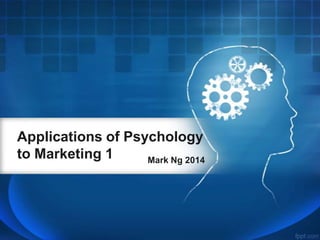Applications of Psy to Marketing - From Two-system Perspective
- 1. Applications of Psychology to Marketing 1 Mark Ng 2014
- 2. Focus of this course How to do marketing from a psychological perspective?
- 3. How psychology relate to marketing? ŌĆó Do you think consumers are rational?
- 4. Traditional views about consumers ŌĆó Consumers are rational decision makers ŌĆó Their decision making process would be affected by different factors ŌĆō Psychological factors ŌĆō Personal factors ŌĆō Social factors ŌĆō Cultural factors
- 5. TodayŌĆÖs class Reading: Kahneman, D.(2012). Ch.1 Barden, P. (2013). Decoded Ch. 5, 6
- 6. Two system perspective System 1 Autopilot Implicit System 2 Pilot Explicit Input Decision
- 7. Characteristics of two systems System 1 System 2 Perception and Intuition Reflection Action Fast Parallel Automatic Effortless Associative Slow-learning Thinking Slow Serial Controlled Effortful Rule-governed Flexible
- 8. Evidence of two systems: ŌĆó Stroop tests ŌĆō Automation vs Manual
- 9. ŌĆó Experience of autopilot
- 10. Auto pilot Sense and Autopilot Pilot Skin Ear Eye Tongue Nose
- 11. Two systems in conflict
- 12. Pepsi Challenge (1980s) ŌĆó Why Pepsi prevails in test, but Coke takes the market?
- 13. Coca Cola = Santa Claus?
- 14. Learning System 1 Auto pilot ŌĆó Associative learning ŌĆō Classical and operant conditioning ŌĆō Imitation System 2 Pilot ŌĆó Cognitive learning ŌĆō Information processing ŌĆō Social cognitive learning
- 15. Formation of associated network ŌĆó System 1: all sort of sensory information linked to the brand
- 16. Associated meanings types ŌĆó Common examples: ’āśBrand-specific ŌĆō claims ’āśAd-specific ŌĆō ad execution, message ’āśBrand identification ŌĆō logos, trade dress ’āśProduct category ŌĆō occasion ’āśEvaluative reactions ŌĆō positive/negative emotions
- 17. Product and Psychology ŌĆó How consumer make their choice? ŌĆó Why new product fails? ŌĆó Why you pay more for brands? ŌĆó Issues of changing package design
- 18. How consumers make their choices? How you choose among them?
- 19. Traditional views ŌĆó Motivation ŌĆō needs and wants? ŌĆó Multi-attribute model? ŌĆó I like it, so I buy it?
- 20. HoweverŌĆ” ŌĆó We have different needs and wantsŌĆ” ŌĆó We are not so rational all the time ŌĆó We like many things, but we may not buy them (Berns & Moore, 2012)
- 21. New perspective: Goal Value Perspective ŌĆó Reward centre of our brain predicts purchase (Berns & Moore, 2012; Knutson et al., 2007) ŌĆó Activation of reward centre (OFC Ventral Striatum) ’āĀ Future sales
- 22. Goal value perspective ŌĆó Reward center determine willingness to pay ŌĆó The more relevant a product to an active goal, the higher the expected reward and willing to pay ŌĆō Products and brands offer high goal value ’āĀ consumers have a high willingness to pay when they fit their goal
- 23. ŌĆó Implications on STP: ŌĆō The consumer goal, not the customer or the category, is the fundamental unit to define the market ŌĆō E.g. what are the goals for drinking coffee?
- 25. ŌĆō Positioning ŌĆó Goal-based category = define competition and position ŌĆō Coffee: Competitors for recharge vs Competitors for relax ŌĆó Product with good positioning = products clearly offer high goal values in a particular category ŌĆō When I think about drinking a coffee for relaxation, I would go toŌĆ”. ŌĆó Which goal activate the brand? ŌĆō By purchasing this product, out customers want to be, have, doŌĆ”.
- 26. ŌĆó Summary: ŌĆō People choose products and brands relevant to their achievements of goals ŌĆō Goals are basic unit of understanding consumer purchase ŌĆō Goals can be activated and pursued on autopilot


























